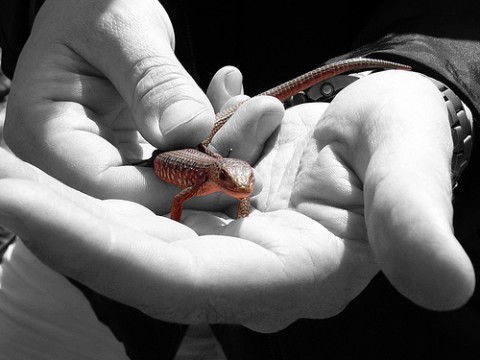Working the Lizard in Us
April 15, 2010 Leave a commentScience has confirmed what many of us feel, that we are each more than one person. We are minds and bodies, left brains and right brains, controlled and automatic responders. This last division is due in part to the fact that we each have more than one brain. Our old reptilian brain is what we can depend on to keep us safe from physical harm most of the time. Our newest brain is what gives birth to the wonders of critical thought and creativity. The amazement I feel about the evolution of our higher thinking is dampened somewhat by my understanding and experience that my multiple brains are not often well coordinated. I walk into a meeting on the one hand (or brain) excited to facilitate, while on the other I am anxious, my more primitive wiring believing there’s a saber toothed tiger in the corner). Welcome to what Seth Godin calls “the lizard” inside.
The lizard is our angst, our fear, our protection mechanism, and it can be an impediment to seeing and working effectively with reality. In groups the lizard may reel its head through displays of resistance, aggression, and general cantankerousness. It may strive to protect even in cases when this is not warranted. It tends to be short-term in focus, even when thinking long-term is in our best interest. Absent our awareness of its tendencies, we can unknowingly feed our and others’ lizard. So how can we, as leaders and facilitators, better manage our reptilian selves and help people stay in their higher brains? Some thoughts:
- Our lizard brains may be on alert because of discomfort owing to new (and unfamiliar) people and processes. As facilitators and leaders, it may be important to let people know that they should expect some discomfort at the start or along the way and that this is all a natural part of learning and of innovating.
- Some of people’s fears may be related to concerns about failure. Framing failure as implicit to growth, and that the overall emphasis is on improving as opposed to proving ourselves, might help tame the lizard.
- Keeping people focused on the outcomes of their efforts, the bigger vision, entails higher order thinking and may allay some irrational concerns about personal safety.
- Letting people hide behind their positions and titles and existing knowledge is giving in to the lizard. Instead, speak to and call on the larger potential in each individual and the group as a whole beyond their formal roles and education.
- Amidst uncertainty about how we will get to our goals, expressing confidence that we will get there can help by-pass the lizard. As can pointing out how we are already manifesting our goal through our risk-taking, new ways of talking, new relationships, etc.
What would you add?

No Comments
Lizard brains! I love it! Thanks, Curtis.
I love this topic. I would like to add a layer, literally.
There is also a middle brain layer between our reptilian brain and our uniquely human neo-cortex. Our limbic brain, in form and function is similar to other mammals and it allows us bond with others through shared joy and grief (and a host of gradient emotional experiences, such as compassion, camaraderie, etc.).
I think for us to “collectively” tap into our higher brain functions of creative, visionary, holistic solutions, we need to access this brain layer of increased relational connectivity. We need to bond as a human tribe with shared understanding of our pain (much of our current reality) and gain (what we can hope for if we begin to collaborate for something bigger than us).
I think all interactions, facilitations, new approaches, deep systemic work, etc. needs to intentionally account for this aspect of human (and mammalian) experience.
Thank you, Jonathan, for your important addition. I/we couldn’t agree more. We are talking more explicitly about the role of “love” in the work of social change and the need to balance our higher brain function of analysis with the limbic gift of connectedness. At last week’s GEO Conference, the opening speaker talked about the need for greater empathy in philanthropy. Interesting reactions in the room, with a fair number of nodding heads.